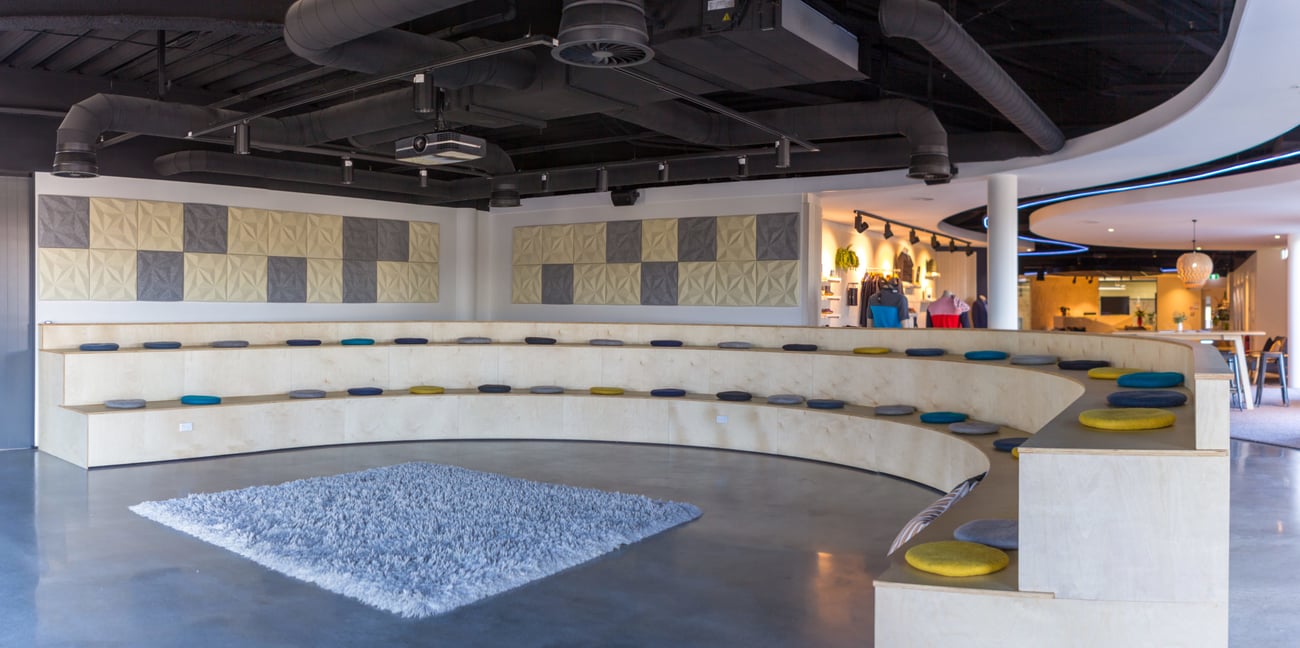Meet Floc 3D, the new acoustic panel set to join the wool renaissance

At the event, John Brakenridge, chief executive of the New Zealand Merino Company proclaimed: “There is a tipping point as the world is discovering Merino and fine wool and we feel that opportunity now exists with strong wool.”
The common narrative that underpins the value of woollen products is sustainability. In a world plagued by synthetic plastics, consumers and businesses have become increasingly keen to find an alternative.
In case you have been living under a rock, the 2.2 billion dollar textile trade represents the second largest industry polluter behind oil and gas, where by in 2050, it is predicted that there will be more plastic in our oceans by fish.
For New Zealand, wool provides a very viable solution. Modern success stories – Allbirds, Icebreaker, and Firewire – are living, breathing examples of its commercial potential.
From shoes to surfboards, these innovations have garnered huge interest from overseas, as well as large sums of investment. In April, Icebreaker was sold to VF corp, who owns Vans, The North Face, and Timberland, for a staggering $288 million, while Allbirds has stitched itself into national business prestige, currently valued at a whopping US$1.4 billion, a number that seemingly never stops growing.
However, while both fine and merino wool have enjoyed renewed glory, strong wool has struggled to cultivate the same opportunities. But, those days could be over, as local designers, entrepreneurs, manufacturers and farmers rub shoulders to find new applications for strong wool.
The product:
The latest innovation, Floc 3D, harnesses the natural fibre to provide an architectural solution for acoustic panels. It’s locally sourced and manufactured, it’s renewable, and it’s 100 percent biodegradable. “It is a product that has been grown, not manufactured by fossil fuels,” says Brakenridge.
The range of tiles are made from woollen fibres pressed into a 3D configuration to give acoustic and wellness benefits to the interior environment. They’re perfect for those stuck in sedentary office jobs or sterile urban dwellings, as they provide a window into New Zealand’s bucolic existence.

T&R architectural manager and acoustic specialist Hedda Oosterhoff says, “It’s a no brainer when you think about it, we have a country full of sheep, they grow a fleece every single year, there is a glut of strong wool, and it has so many amazing properties, so it makes sense to bring those properties into an interior space.”
Floc 3D taps into “the invisible side of architecture”, according to Brakenridge, which is connected to how we interact with an interior space. One of the problems the acoustic tiling sets out to solve, or at least improve, is sound absorption.
Oosterhoff says: “The number one complaint in offices is noise, the number one complaint in restaurants and bars is noise, it’s a huge litter on our daily lives, it’s not only annoying, but it affects our mental health.”
We are not talking about noise that gives you hearing damage, we are talking about background noise, which increases your heart rate, increases your stress levels. In restaurants it makes you eat faster, and drink more, which are stress responses to the noise. If you can only understand 30 percent of what is being said, your brain is working overtime to fill in those blanks.”
If you’ve ever had a meeting and come out with a headache, that is why.”
To fix the blight of noise on our daily lives, Floc 3D enables extremely high Noise Reduction Coefficient (NRC) to reduce reverberation time. In layman’s terms, the woolen acoustic tiling helps to block out irritating background noise and controls acoustic indoor surroundings by helping maintain indoor temperature and reducing energy consumption.

Another wellness benefit of Floc 3D is indoor air quality, which has been highlighted as a generational challenge.
Wool could be a tonic to poor interior air quality, according to Oosterhoff, who estimates that the use of wool in interiors can help purify the air for up to 30 years, and is allegedly a resistant to bacteria, mould and mildew that can trigger allergic reactions.
Brakenridge says these multiple benefits allows Floc 3D to bring nature into an interior space – perhaps a modern ailment, with recent statistics suggesting ‘the average child in the US spends more time indoors than a prisoner.’
The timing:
The original concept – to harness the thermal and acoustic potential of wool – was originally mooted 25 years ago, according to Oosterhoff. She says, “It was never commercially viable then because we were on such a good wicket with carpet, there wasn’t the drive to test new products and try new things, but here we are 25 years later and it has come around again, the market is now ready for it.”
Currently, the majority of existing acoustic products are imported from overseas, which Oosterhoff says has a huge carbon footprint and is absurd considering our access to natural materials.
Although the Floc 3D wool acoustic panel is only one product, it provides a vision for both strong wool and the textile industry.
Brakenridge says, “We work on bringing on the farm right through to the value of brands. Our growers reckon they’ve got something special in wool and we’d like to connect them with designers and architects.”
This is echoed by Oosterhoff: “New Zealand is a prime place for this obviously with our huge exposure to wool. We’ve got this amazing resource, the question is how do we use it.”
As patriots (or unashamedly big fans of local business), Idealog has done its bit to pedal the wool renaissance, by teaming up with The New Zealand Merino Company to unveil the Wool-ovation competition. To find out more read the link here, but be in quick, it’s the last week to enter!


